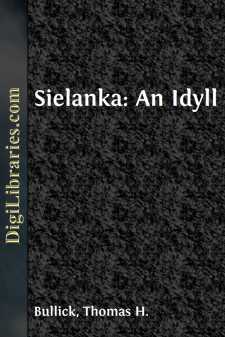Categories
- Antiques & Collectibles 13
- Architecture 36
- Art 48
- Bibles 22
- Biography & Autobiography 813
- Body, Mind & Spirit 142
- Business & Economics 28
- Children's Books 17
- Children's Fiction 14
- Computers 4
- Cooking 94
- Crafts & Hobbies 4
- Drama 346
- Education 46
- Family & Relationships 57
- Fiction 11829
- Games 19
- Gardening 17
- Health & Fitness 34
- History 1377
- House & Home 1
- Humor 147
- Juvenile Fiction 1873
- Juvenile Nonfiction 202
- Language Arts & Disciplines 88
- Law 16
- Literary Collections 686
- Literary Criticism 179
- Mathematics 13
- Medical 41
- Music 40
- Nature 179
- Non-Classifiable 1768
- Performing Arts 7
- Periodicals 1453
- Philosophy 64
- Photography 2
- Poetry 896
- Political Science 203
- Psychology 42
- Reference 154
- Religion 513
- Science 126
- Self-Help 84
- Social Science 81
- Sports & Recreation 34
- Study Aids 3
- Technology & Engineering 59
- Transportation 23
- Travel 463
- True Crime 29
Sielanka: An Idyll
Description:
Excerpt
SIELANKA.
An Idyll.
In the woods, in the deep woods, was an open glade in which stood the house of the forester Stephan. The house was built of logs packed with moss, and the roof was thatched with straw; hard by the house stood two outbuildings; in front of it was a piece of fenced-in ground, and an old well with a long, crooked sweep; the water in the well was covered with a green vegetation at the edges.
Opposite the windows grew sunflowers and wild hollyhocks, high, stately, and covered with blossoms as if with a swarm of gorgeous butterflies; between the sunflowers there peeped the red heads of the poppy; around the hollyhocks entwined sweet peas with pink blossoms and morning-glories; close to the ground grew nasturtiums, marigolds, primroses, and asters, pale because they were shaded from the sunlight by the leaves of the hollyhocks and sunflowers.
The fenced ground on either side of the pathway leading to the house was planted with vegetables—carrots, beets, and cabbage; further off in a separate fenced-in lot there waved with each breath of wind the tender blue flower of the flax; still beyond could be seen the dark green of the potato patch; the rest of the clearing was checkered with the variegated shades of the different cereals that ran to the edge of the lake which touched the glade on one side.
Near to the house a few trees were growing. Some were cherry trees, and one was a birch, with long, slender branches which swayed in the wind, and with every breeze its leaves touched the dilapidated moss-covered straw thatch of the roof; when the stronger gusts of wind bent its boughs to the wall, and pressed its twigs and the waves of leaves against the roof, it would seem as if the tree loved the house and embraced it.
In this tree the sparrows made their home; the rustling of the leaves and twigs commingled with the chirp and joyous noise of the birds; in the eaves of the house the doves had built their nests, and the place was filled with their speech, cooing and calling to each other, entreating and discussing as is customary between doves, these noisy and talkative people.
At times it happened that they were startled by some unknown cause; then around the house was heard a loud flapping, the air was filled with the whirl of wings and a multitude of white-feathered breasts; you could hear tumult, noise and excited cries—the whole flock flew out suddenly, circled round the house, now near, now far off. Sometimes they melted in the blue, sometimes their white feathers reflected the sunlight, again they hung over the house, undulating in the air, and alighting at last like a downfall of snowflakes on the gray straw of the roof.
If this occurred in the rosy morning or in the splendor of the red setting sun, then in the glory of the air these doves were not white, but tinted pink, and settled on the roof and birch tree as flames or scattered rose leaves.
At twilight, when the sun had hidden itself beyond the woods, this cooing under the roof and chirping in the birch tree became gradually quiet....


